Written by Junanto Xu
Edited by Laura Jodoin
Are you craving for a unique travel experience, to immerse yourself completely in another country’s traditions – no matter how bizarre?
If so, this story of truly chilling traditions might be exactly the thrill you’re seeking.
Indonesia is no stranger to strange cultural practices. From one tip of the country to the other, each region possesses a unique culture, with centuries-old traditions that are still kept even today. While some are enchanting and intriguing, many are chilling and peculiar.
Read on to learn more about some of the seriously fascinating cultural practices across Indonesia that are sure to make your jaw drop!
Warning: This article contains graphic images.
1. Death doesn’t mean goodbye – The Death Ritual of Tana Toraja
When it comes to death, some people have a rather unorthodox point of view.
For the people of Toraja, death is not something to be mourned; instead, they see death as the climax of life and an occasion worthy of celebration. In Tana Toraja, the celebration of death is undoubtedly one of the grandest and most complex events that people can witness in Indonesia.
1.a Party for the dead – Rambu Solo and the Makula
The Torajans believe that when a person passes on, the body of the deceased may decay, but the spirit will linger until a grand funeral ceremony.
This ceremony (known as Rambu Solo) may seem to be an occasion of mourning, but the Torajans view it more as a celebration – one that delivers the spirit to the last destination of life, a final resting place referred to as ‘Puyo’.
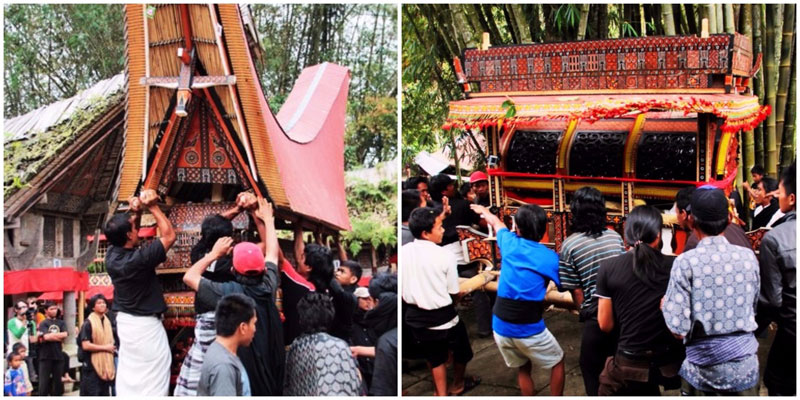
The atmosphere is light, full of laughter and good humour, complete with a feast following a livestock sacrifice, and performances that last weeks. This isn’t just about paying respects to the dead; for Torajans, the scale of Rambu Solo is a representation of social status – so the bigger the party, the better!
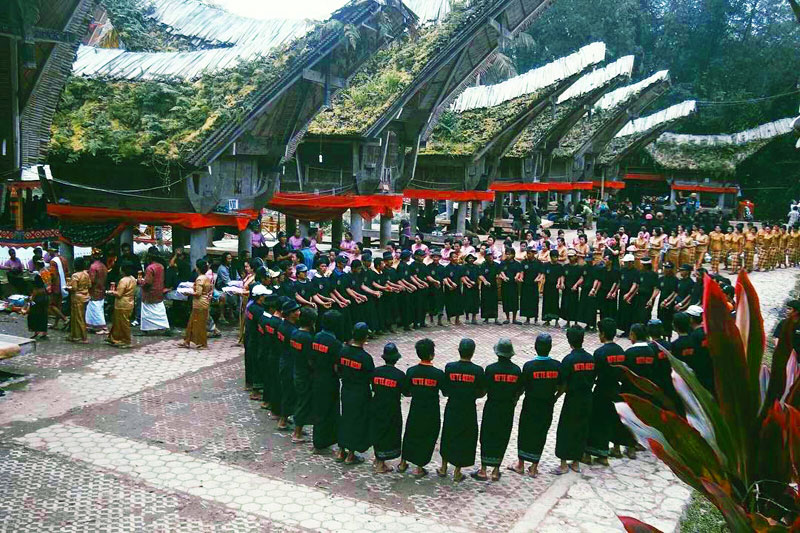
But a big party means big money, and to be ready for the expenses, Torajans may need to save up for years. Thus, before the ritual is held, the body of the deceased will be kept in the house and treated as a sick houseguest (known as a ‘makula’).
Creepily enough, the ‘makula’ will be fed, talked to, and played with like a living person. This is totally normal for the Torajan people, and is a very common practice.
So if you’re lucky enough to see this custom for yourself, don’t freak out if you come across a dead body in someone’s house!
Rambu Solo and the Makula
Getting there: To reach Tana Toraja, you can take a flight from any major Indonesian city to Sultan Hasanuddin airport in Makassar. After arriving in Makassar, take a 10-hour bus trip to Rantepao, the capital of North Toraja. For more bus information, click here. Coordinates here.
Contact: [email protected]
Best time to catch the ritual: The schedule for this festival is tentative as every family holds their ceremony on different dates. Peak seasons are in June, August and September.
To be updated on the funeral dates, check out Visit Toraja’s official Instagram page.
Website 1.b The spirit of the dead lives: Tau-Tau
The funeral culture in Tana Toraja doesn’t end with Rambu Solo! Torajans who firmly believe in an afterlife will continue to honour the deceased, and maintain a link between the living and the dead through what is known as a ‘Tau-tau’.
A Tau-tau is an effigy carved from wood or bamboo that represents the deceased, usually resembling the person who has died and can be found near their grave. Torajans believe that the spirit of the dead will continue to live on through the Tau-tau and serve as the guardians of the tomb and saviour of the living.

You can see these Tau-tau at a gravesite known as Kuburan Batu Lemo, about 12 kilometres south of Rantepao. Consisting of 75 holes in a rock wall, some of which are filled with Tau-tau, this tomb is estimated to have been built around the 16th Century, and hence is the second oldest in Toraja.
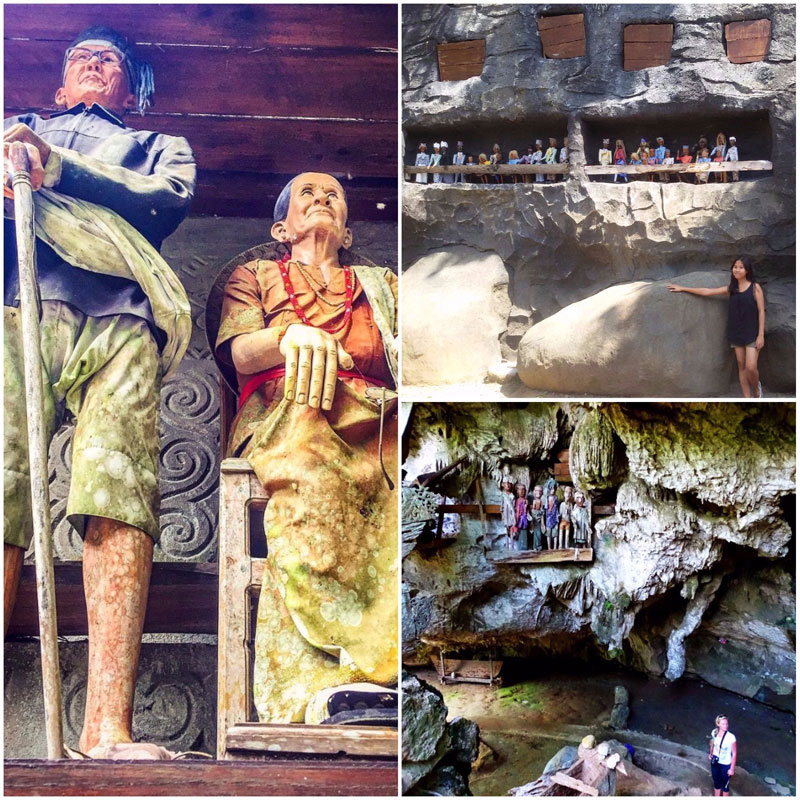
Tau-Tau
Address: Jl Poros Makale – Rantepao, North Makale, Tana Toraja, South Sulawesi. Coordinates here
Entrance fees: Rp. 10,000 (approximately USD 0.75)
1.c Bringing the dead back from the grave: Ma’nene
Yes, the Torajans literally bring their deceased loved ones back from the grave.
This is done in order to perform a shocking yet heartwarming ritual called Ma’nene.
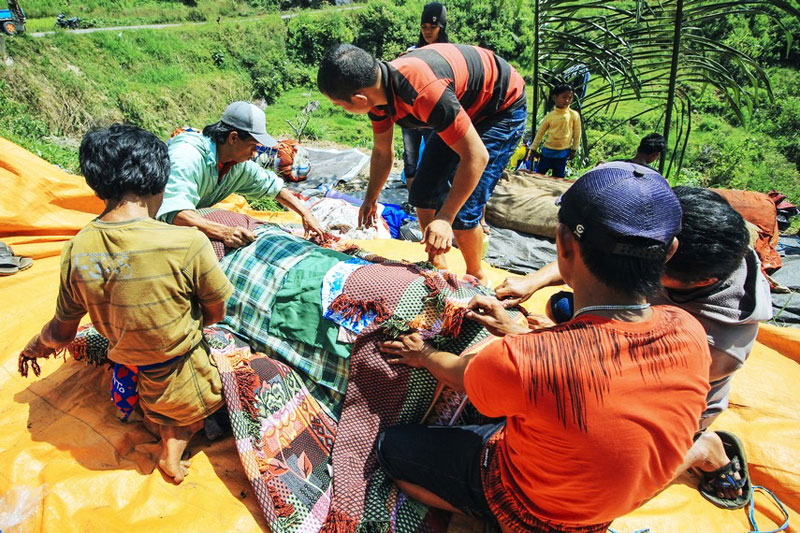
Ma’nene is a way for Torajans to continually pay respects to their dead relatives, even long after the death has occurred. Every three years, the corpse will be exhumed, washed, cleaned, and dressed in finery (often the deceased person’s best or favourite clothes).
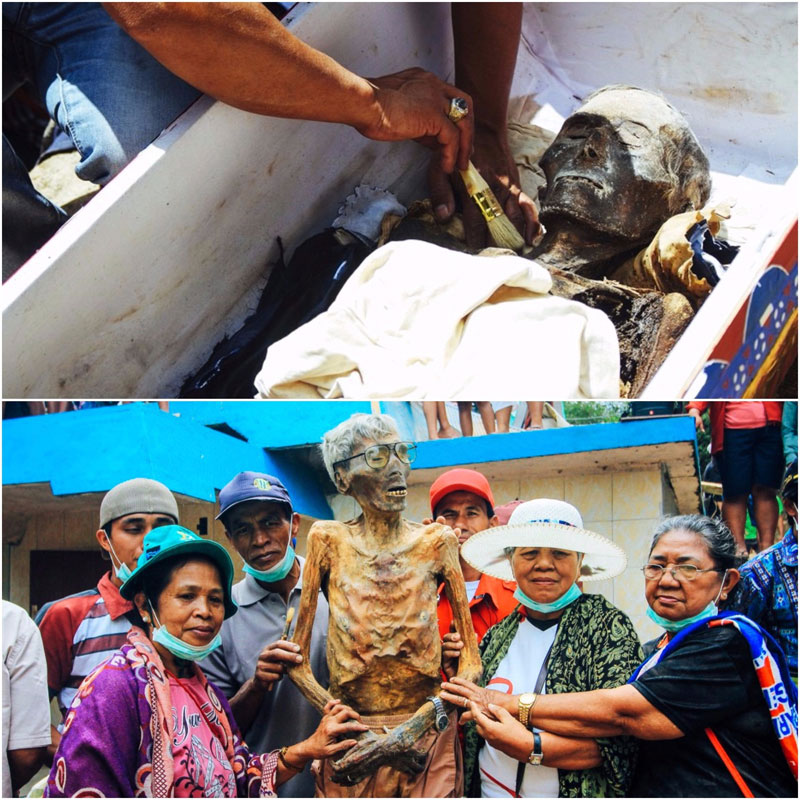
After this cleansing and dressing ceremony, the family will pose for photographs with the person, and return them to the grave.
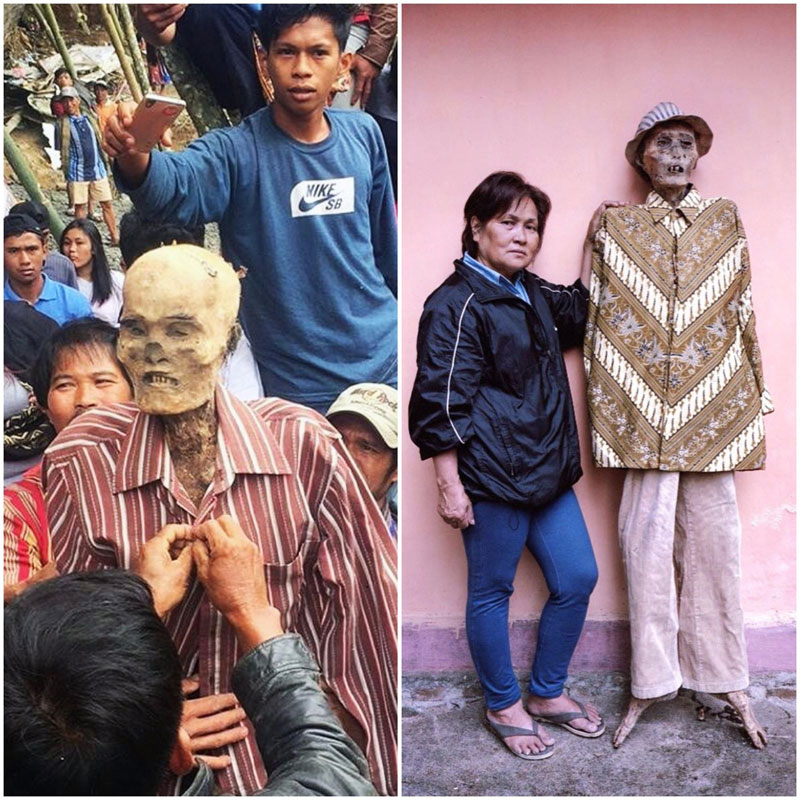
This festival can be observed in the village of Baruppu.
Ma’nene
Address: Baruppu, North Toraja Regency, South Sulawesi
Getting there: You can take a bus or minivan in Rantepao Bolu Terminal to reach Baruppu. Since there are no timetables and very little route information, you may need to ask a local or the bus driver for help or directions.
Another alternative way to reach Baruppu is by using a local motorcycle (ojek) or pete-pete which can be easily spotted in Rantepao. Do ask and confirm the price first to avoid overly expensive fare and additional charge, especially as a traveller!
Coordinates here.
Best time to catch the ritual: This ritual is conducted once in every 3 to 5 years around August after the local harvest season. No specific date has been set.
1.d Burying dead babies in the hole of a tree: Passiliran
You read that right. This particularly shocking custom involves a baby cemetery at the base of a tree.
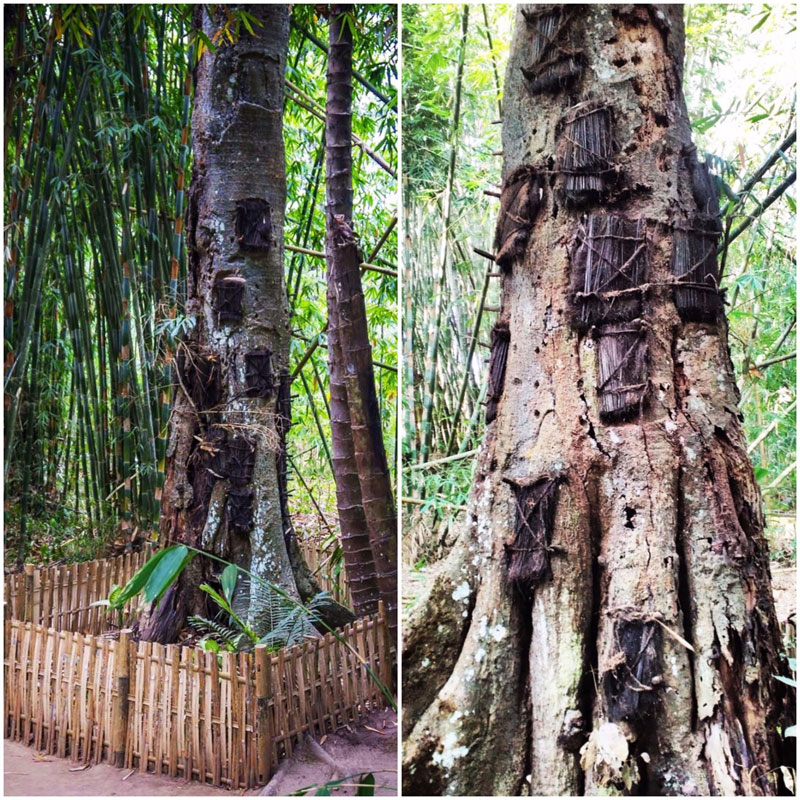
Babies under six months of age (and without teeth) were considered sacred by the Torajans. So if the babies of Torajans die before reaching six months old, they would be wrapped with ‘Enau’ leaves and buried inside the hole of a ‘Tarra’ tree, symbolising the return of the baby into their mother’s womb.
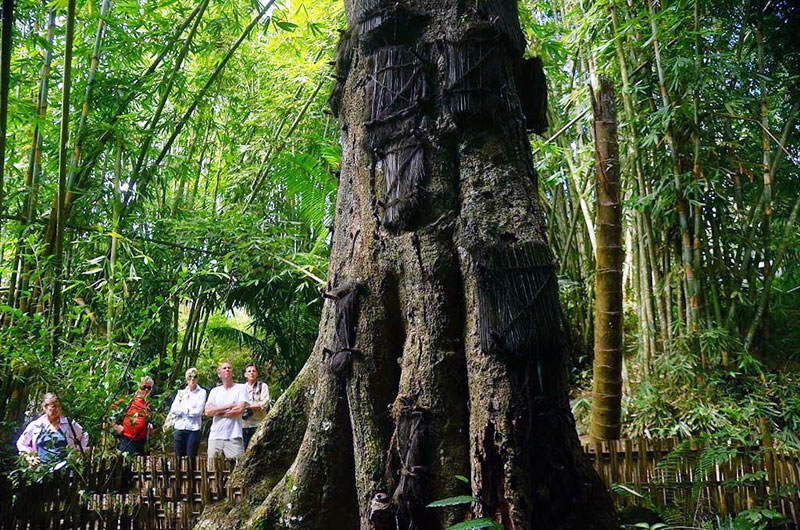
Although this tradition is slowly fading away, these baby graves can still be found in Tana Toraja as a way of preserving authentic culture.
Passiliran
Address: Tongko Sarapung, Sangalla, Tana Toraja Regency, South Sulawesi 91881. Coordinates here.
Entrance fees: Rp. 20,000 for international tourists (approximately USD 1.50) and Rp 10,000 for Indonesians
2. The water buffalo cosplay – Kebo-Keboan
Every culture or religion has a unique way of offering devotion to their gods. Some through the prayer, some through meditation, and some through sacrifice. But this particularly odd custom involves impersonating a water buffalo!
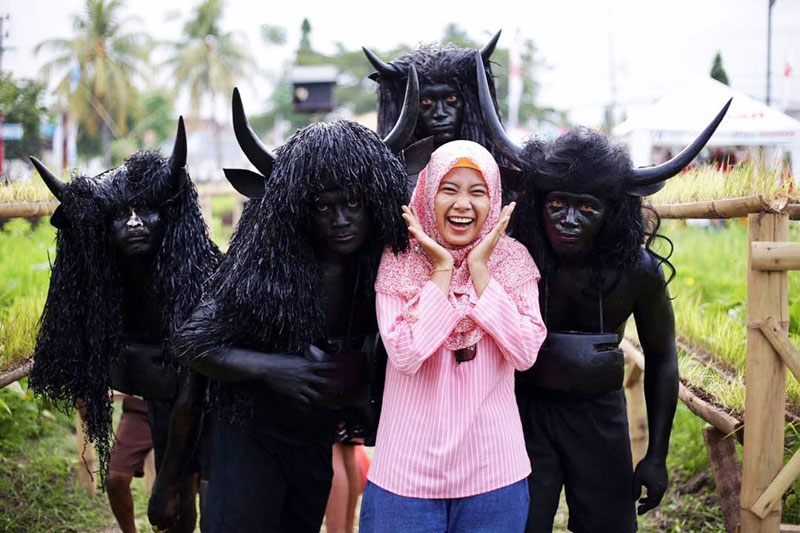
On every Muharram or Suro month according to the Javanese calendar, ‘human water buffaloes’ will roam the streets in the villages Aliyan and Alasmalang. Have no fear! These ‘water buffaloes’ are actually just men smeared with charcoal and oil. They hang a horn and bell around their necks and parade through the village streets.
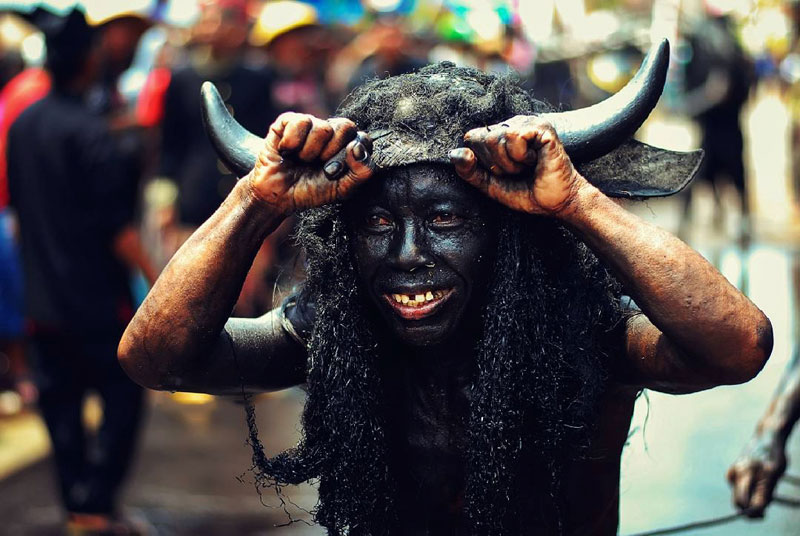
Kebo-keboan (literally translated as impersonating a water buffalo) is truly an unorthodox method of asking for rain for crops and protection from their god, as water buffaloes are considered the most sacred and powerful animal due to their uses in farming (the main village livelihood!)
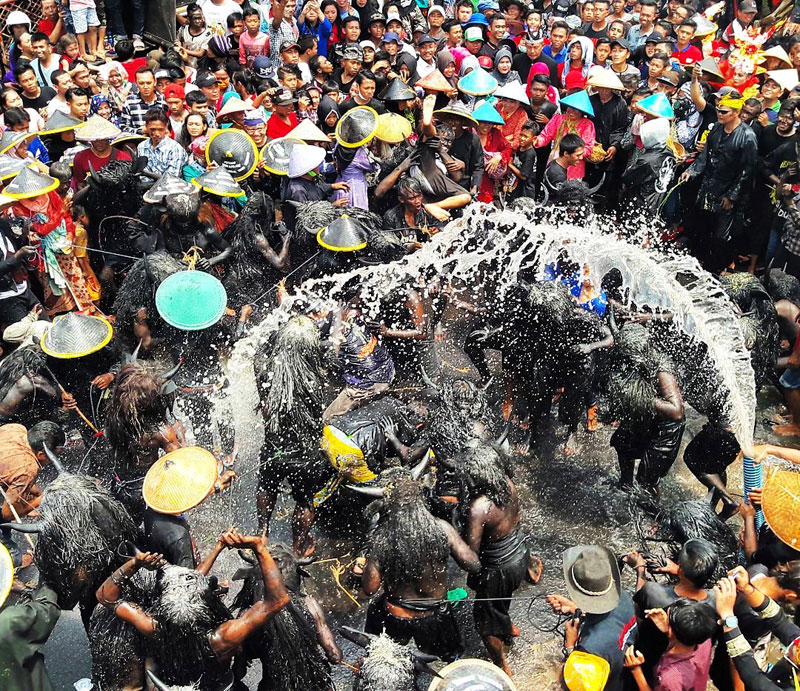
So don’t panic if you see people running up a storm in the village streets covered in charcoal and mud – it’s only a prayer!
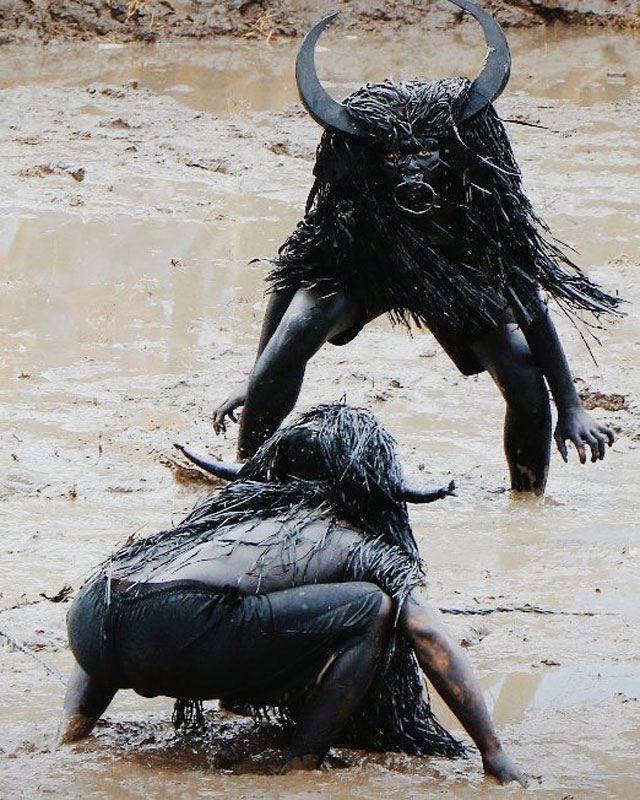
3. Superhuman powers – The ancient martial art of Debus
Are you a fan of superheroes? Well, in Banten, you might actually get to meet one.
Debus is a martial art originating from Banten, with a focus on developing tolerance to pain (particular self-inflicted stabbing).
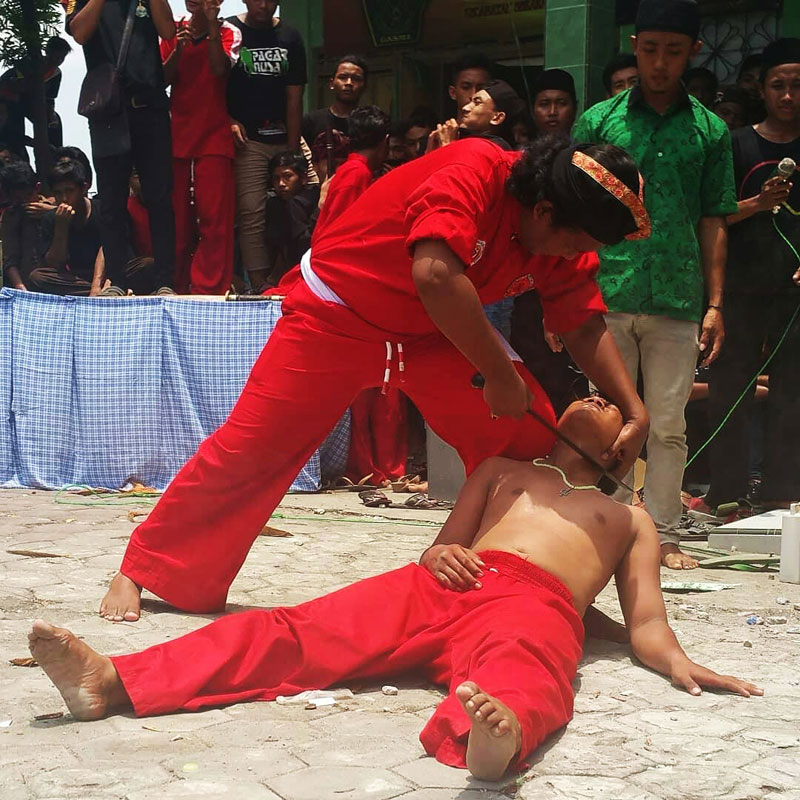
The performer (known as Jawara) endures sword stabbing, machete slicing, or even belly piercing by spears. Other mind-blowing abilities include eating fire, chewing glass, and inserting needles into various body parts. These acts supposedly leave no trace of injury or harm – they believe that they would be unharmed because this is a sacrifice to their god.
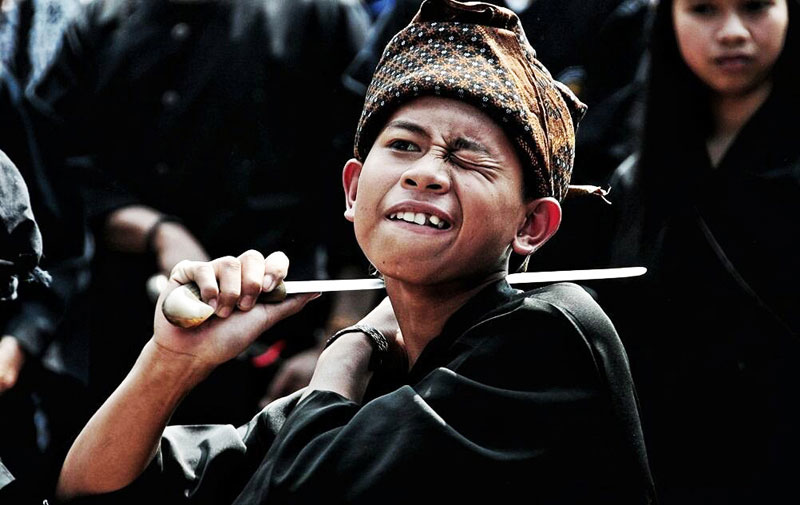
As amazing as this level of resilience to pain may be, there’s nothing supernatural or truly superhuman involved, it just means the individual has an astounding level of pain tolerance.
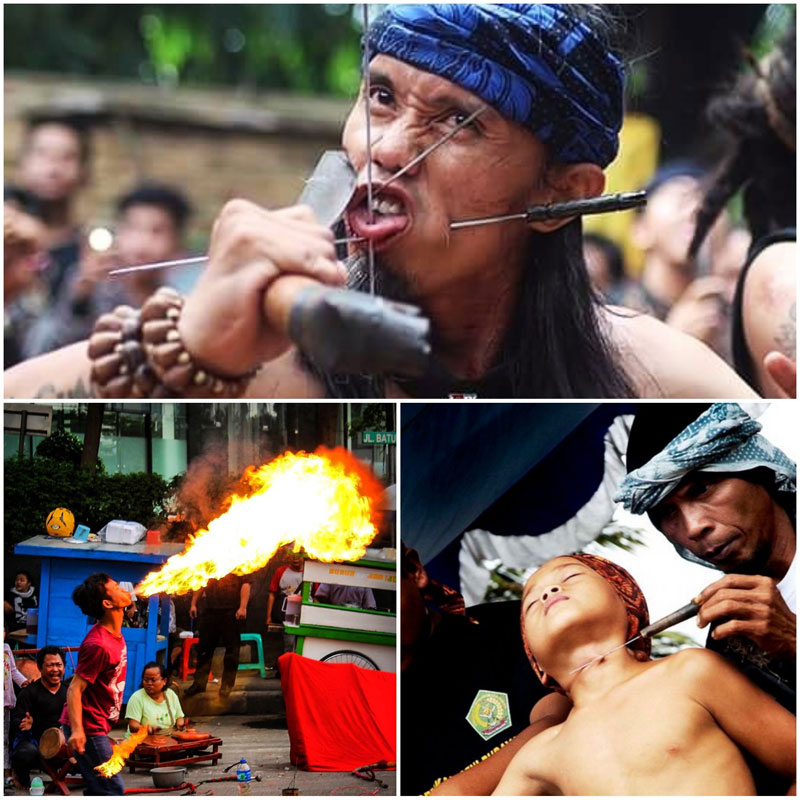
Thus, Debus involves not only physical hardship, but vigorous mental training. To perform this martial art, near-superhuman inner strength, pain endurance, and years of practice are paramount.
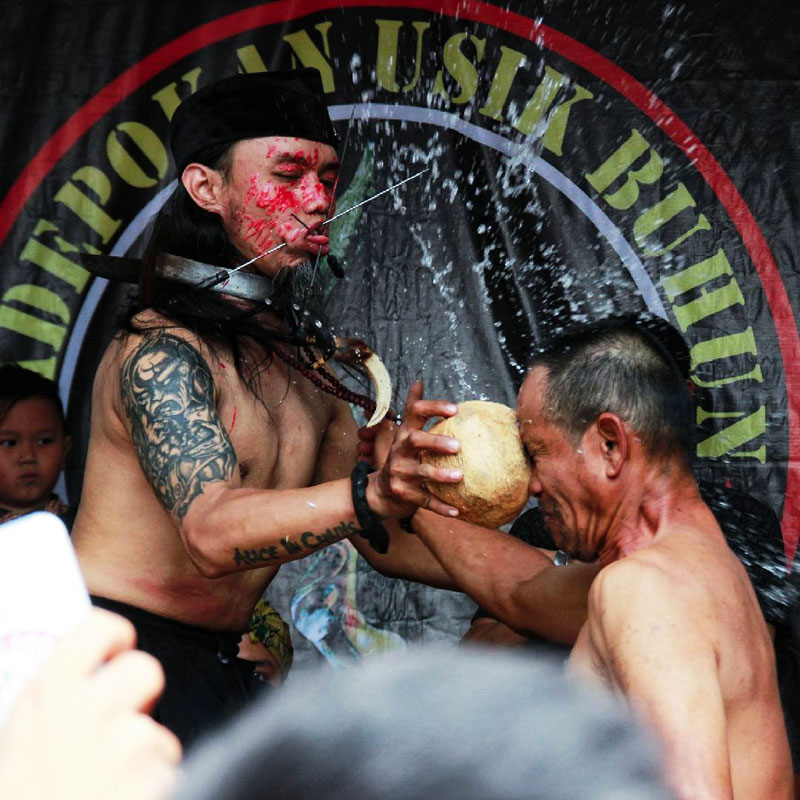
According to various sources, Debus first emerged in the 16th Century as a means to spread Islam. Later, during the reign of Sultan Ageng Tirtayasa in the 17th Century, this martial artistry was used to boost morale of soldiers against the Dutch colonial powers of the time. And Debus is very much still in practice today.

But no matter how impressed and curious you may be, we strongly advise you not to try this at home!
The ancient martial art of Debus
Where to visit: Debus can be easily observed in major cities in Banten such as Serang, Pandeglang, Lebak, and Tangerang.
Serang coordinates here
Pandeglang coordinates here
Lebak coordinates here
Tangerang coordinates here
Best time to catch the ritual: Debus can be seen at most major events or festivals in Banten, so there are no designated dates for performing this tradition.
4. Bloody harvest festival – Pasola
Did you know that south of Komodo Island, there is an island that annually holds one of the bloodiest and most extravagant harvest rituals in the world?
Sumba Island is a remote island where you can witness a particularly bloody Thanksgiving ritual called Pasola, an ancient war ritual performed by Sumbanese men.
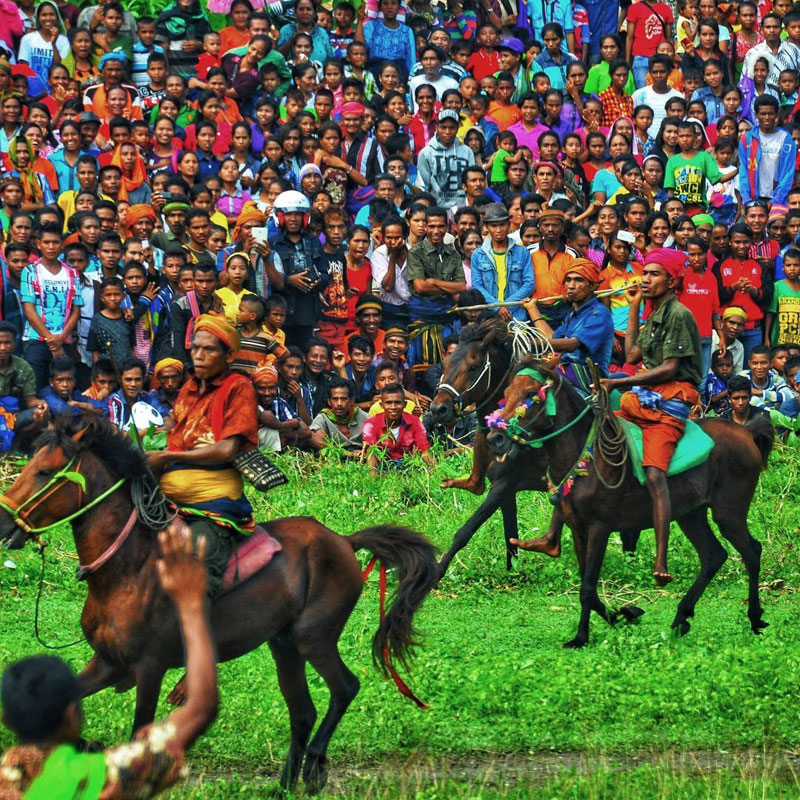
In this ceremony, 50 men will divide into two groups and mount a handsomely decorated horse to stage a mock war. Spears will be flung toward opponents, who will need to dodge the onslaught of weapons (although a skillful rider may catch it and hurl it back!). Though the ends are blunt, the spears could still cause serious damage such as severe injury or even death.
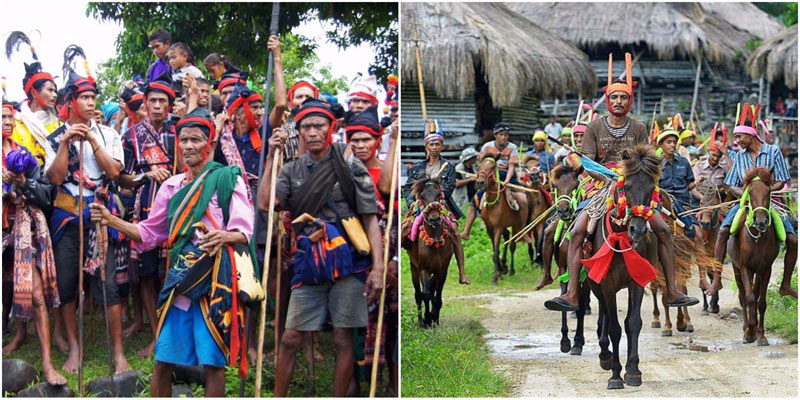
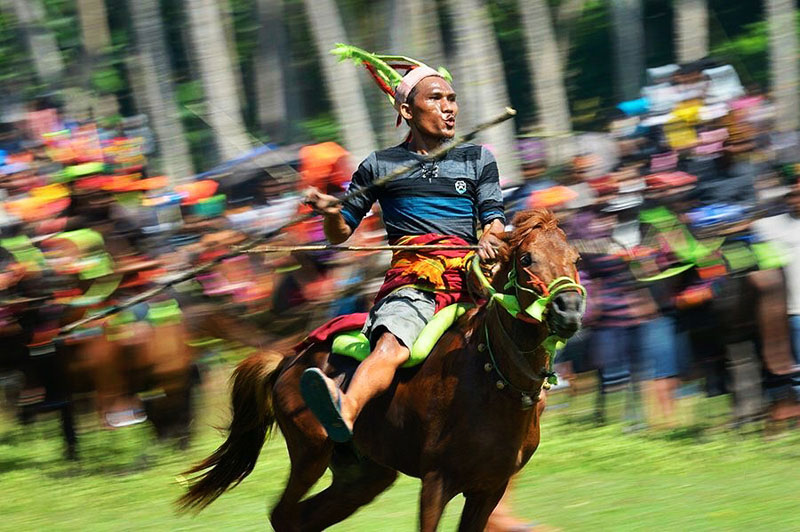
Despite the risks, the Sumbanese firmly believe that the pain and blood are never wasted. They believe that the spilling of blood will fertilise the lands and result in more plentiful harvests in future.
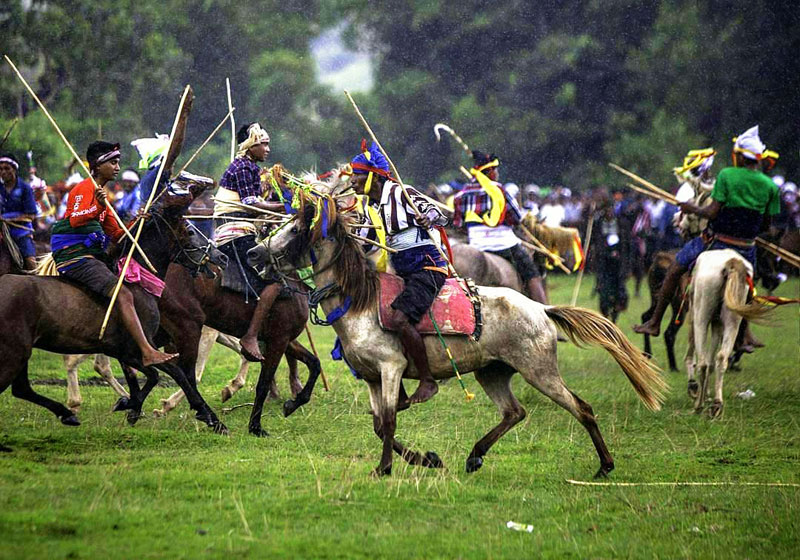
Pasola
Address: West Sumba Regency, East Nusa Tenggara, Indonesia
Getting there: The fastest and easiest way to reach West Sumba is to take a flight from Bali or Kupang to Tambolaka Airport, Southwest Sumba. After reaching Southwest Sumba, you can continue via land transportation.
Car rentals, travel agents and buses that head toward West Sumba can be easily found near the airport, with each trip costing around Rp 500,000 (approximately USD 37.59), Rp 50,000 (approximately USD 3.76), and Rp 10,000 (approximately USD 0.75) respectively.
Coordinates here.
Best time to catch the ritual: Generally held for four weeks during February and March, depending on the arrival of a type of sea worm called nyale. When this worm is found swimming ashore, it signifies the end of the rainy season and the beginning of crop-planting.
5. Burning of the last ship – Bakar Tongkang Festival
Decades ago, a group of Chinese immigrants from the Fujian province sailed from their hometown in a simple wooden boat, seeking a better life. Guided by two Chinese deities, they finally reached and settled in an unknown land (today known as Bagansiapi-api).
As a show of determination and strength of will, they decided to torch their ship as a symbol of their resolve to stay and never return to their homeland.
Today, this historical event is commemorated every year though a festival known as the Bakar Tongkang (which means the burning of the last ship).
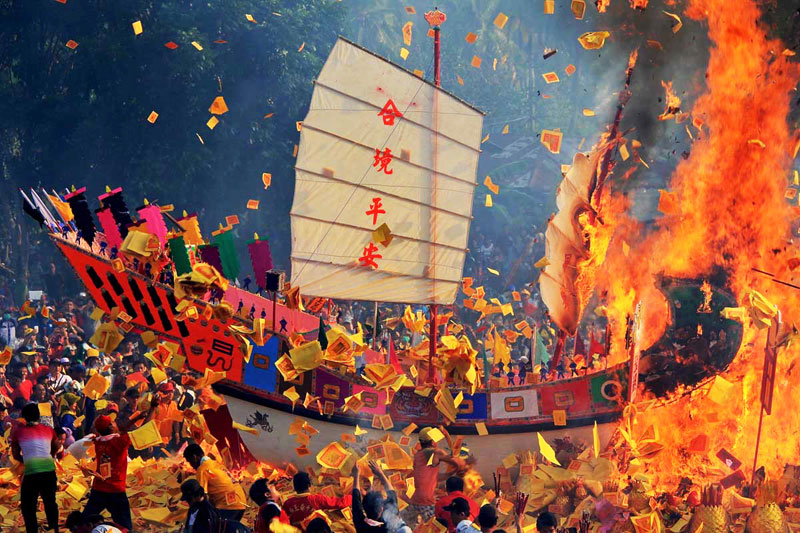
Bakar Tongkang festival is celebrated every year, and is practised to remind the younger generation of the struggle and sacrifice made by their ancestors.
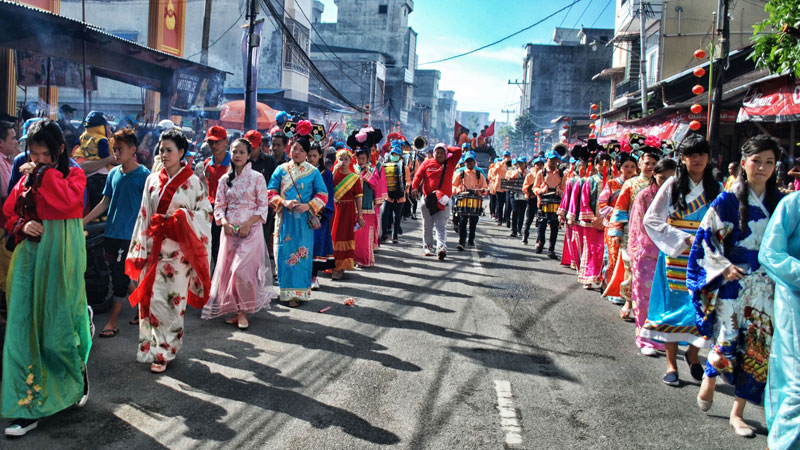
Throughout the event, the streets are filled with cultural attractions such as Barongsai (Lion Dance), the Chinese costume parade, prayers, dancing and singing.
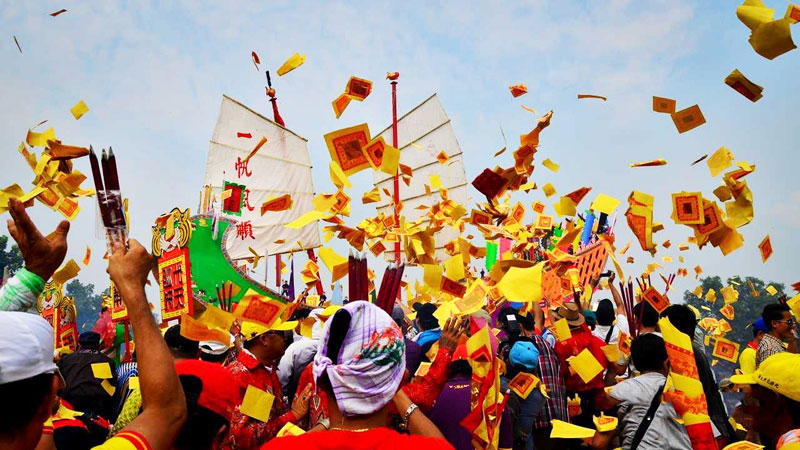
The pinnacle of the festival, of course, is the burning of a Chinese ship replica weighing up to 400 kg. The ship will be burnt, accompanied by joss paper (also known as paper money), creating a spectacular sea of fire.
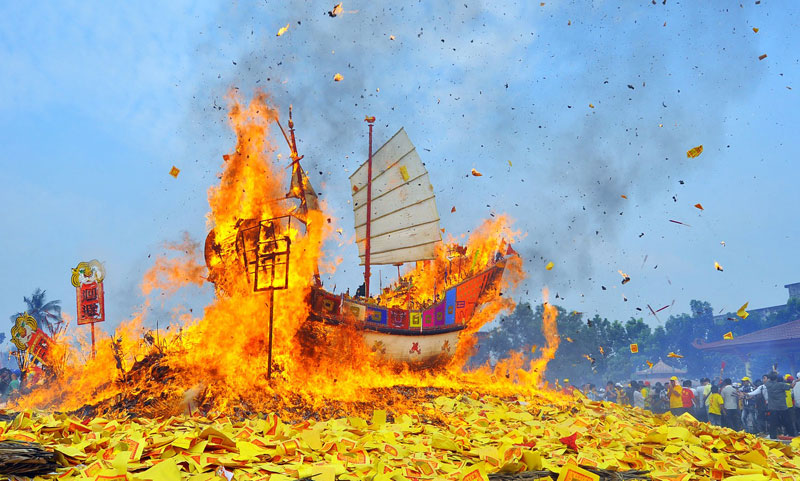
Bakar Tongkang Festival
Getting there: There are many ways to travel to Bagansiapi-api from the capital of Riau Province, Pekanbaru (flights here can be easily found). With a total distance of 350km, it will takes 4-6 hours via land transport.
By bus: There are around 5 bus companies that operate from Pekanbaru to Bagansiapi-api. Two of the recommended bus companies are:
1. Indah Karya, Ticket fare: Rp 65,000 (approximately USD 4.80), bus available from 08.00-14.00. Contact: +62 761 7002 244,
2. Yala Transport, Ticket fare Rp. 65,000 (approximately USD 4.80), bus available at 08.00, 15.00 and 17.00. Contact: +62 8137 1879 943
By taxi:
1. Puskopau taxi, phone: +62 7612 5500, Rp. 600,000 (approximately USD 45.10) per trip
2. Kopsi taxi, phone: +62 7612 5252, Rp. 750,000 (approximately USD 56.38) per trip.
Coordinates here.
Best time to catch the festival: Around May or June (traditionally, the 16th day of the 5th lunar month).
6. The Extreme New Year Celebration – Singkawang Cap Gomeh Festival
If traditional customs from the Chinese New Year don’t cut it for you, we have something you may like – but enjoy it at your own risk!
On the 15th day of Chinese New Year, the streets of Singkawang City will be jam-packed with hundreds of spectators enjoying the city’s most monumental parade. On this day, lion dances, dragon dances, and other local performances will fill the entire city.
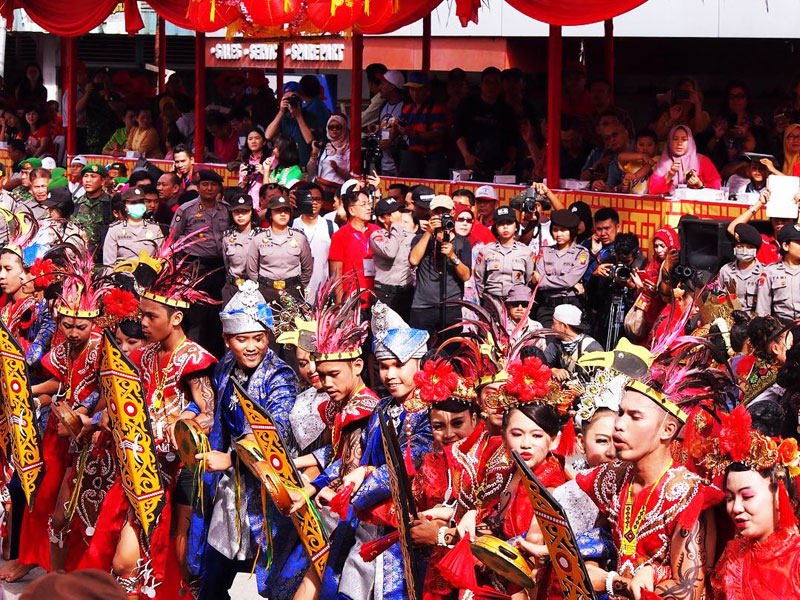
However, the most highly-anticipated feature of this festival is a thrilling and mystical ritual known as Tatung, a human whose body becomes possessed by summoned spirits.
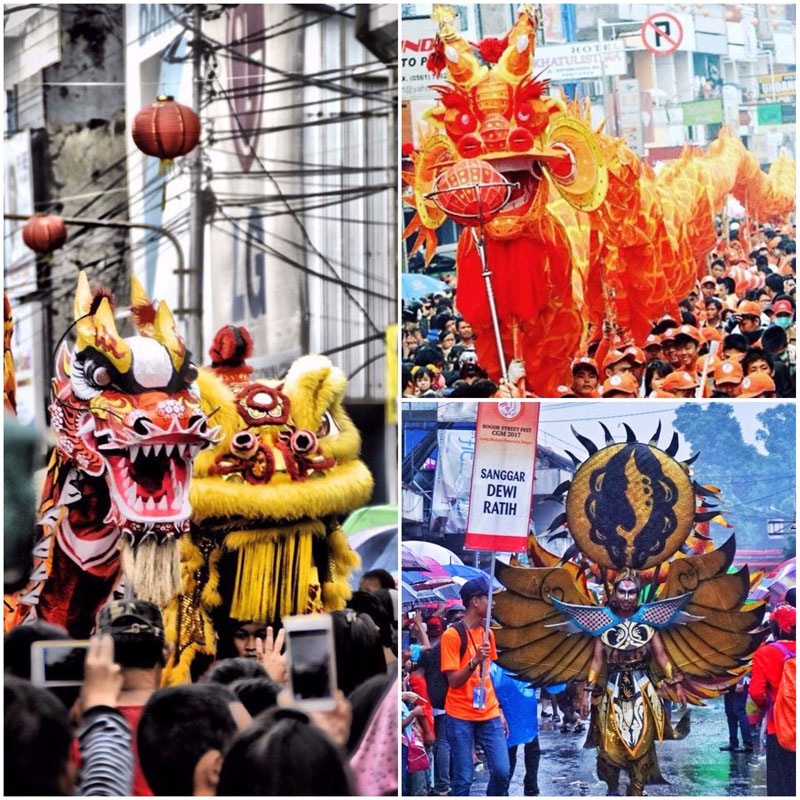
Up to 700 Tatungs will prove their supernatural powers by performing unbelievable acts, such as stepping on swords, piercing their own cheeks with nails, being whipped by metal chains. The Tatung is said to remain unscathed due to the protection by a higher power.
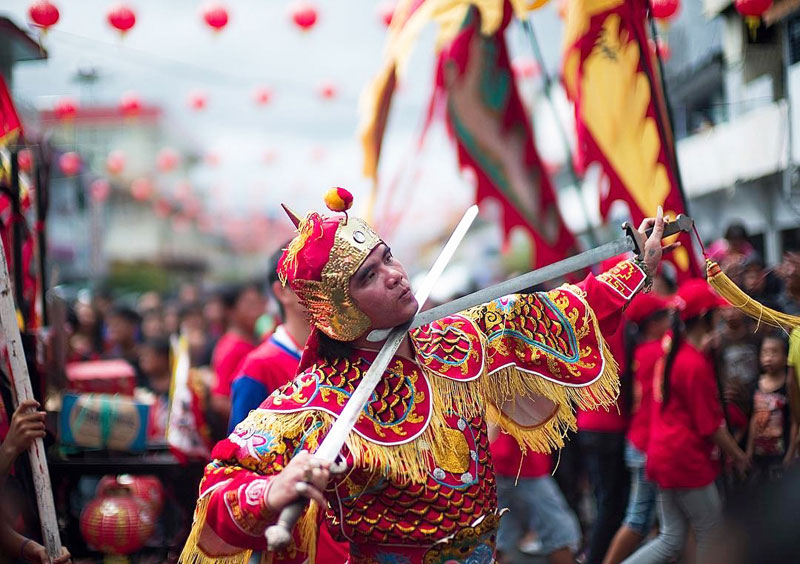
These thrillings performances from the Tatung are believed to be a means to repel bad luck and ensure a good and plentiful year ahead.
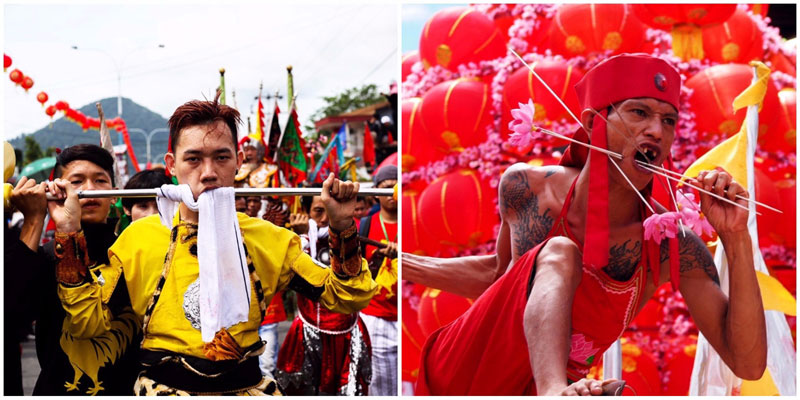
Singkawang is a city primarily populated by those of Chinese descent. According to legend, Singkawang is the central gathering place of the gods, hence that’s why it’s extremely important for the locals to honour such blessed city.
Singkawang Cap Gomeh Festival
Getting there: To visit Singkawang, take a flight from any major Indonesian airport to Pontianak city, west Kalimantan. After arriving in Pontianak, you can either book a rental car or simply use taxi to travel to Singkawang. It may takes up to 4 hours to travel between these two cities and the approximate cab fare is around Rp. 170,000 to Rp. 250,000 (USD 12.70 to 18.70)
Coordinates here.
Best time to catch the festival: Every January or February (the 15th day of Lunar New Year).
7. Grave-digging for good luck – The ritual of Tiwah
Imagine having to dig up your deceased and buried family member for some unavoidable reason – would you be able to do it? In Kalimantan, the Dayak tribe are required to perform this daunting ritual.
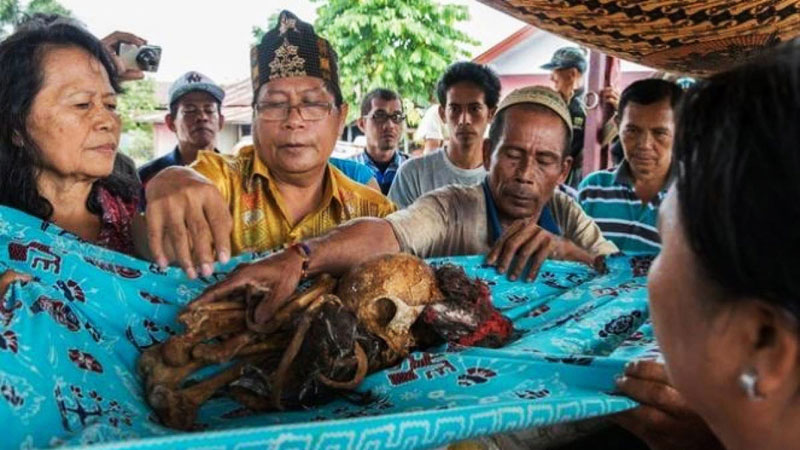
For the people of Dayak, death is merely a transition from this world to the next. However, this transition is only possible after a Tiwah is conducted. Tiwah is intended to deliver the soul of the deceased towards the afterlife by moving what remains of the body (usually just the bones) to a sacred place called Sandung.
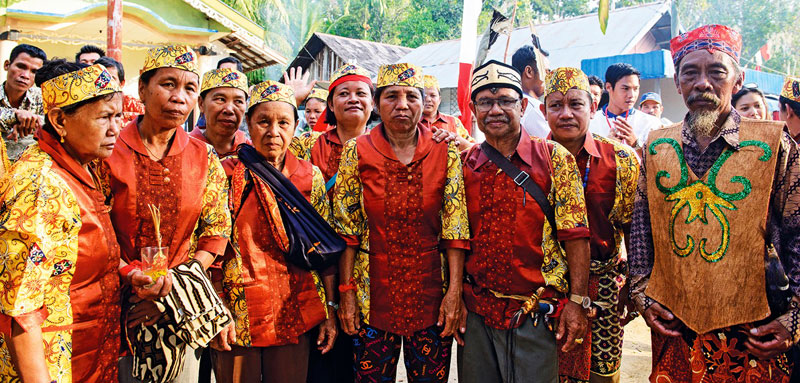
There is no specific time for the family to conduct Tiwah. This ritual can be held any time based on the readiness of the deceased’s family, since a Tiwah ceremony requires a complicated preparation and substantial financial funding.
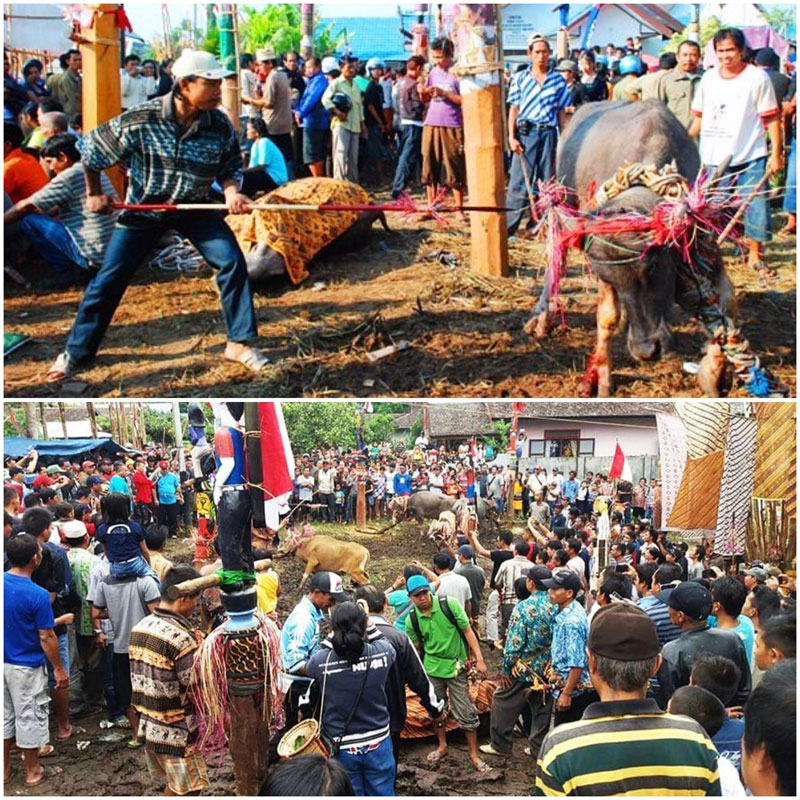
The practice of Tiwah also aims to cast away bad luck and show respect and affection to their ancestors. On the flip side, if Tiwah is not held properly, the locals believe the spirit of the dead will curse the family and bring misfortune to its members.
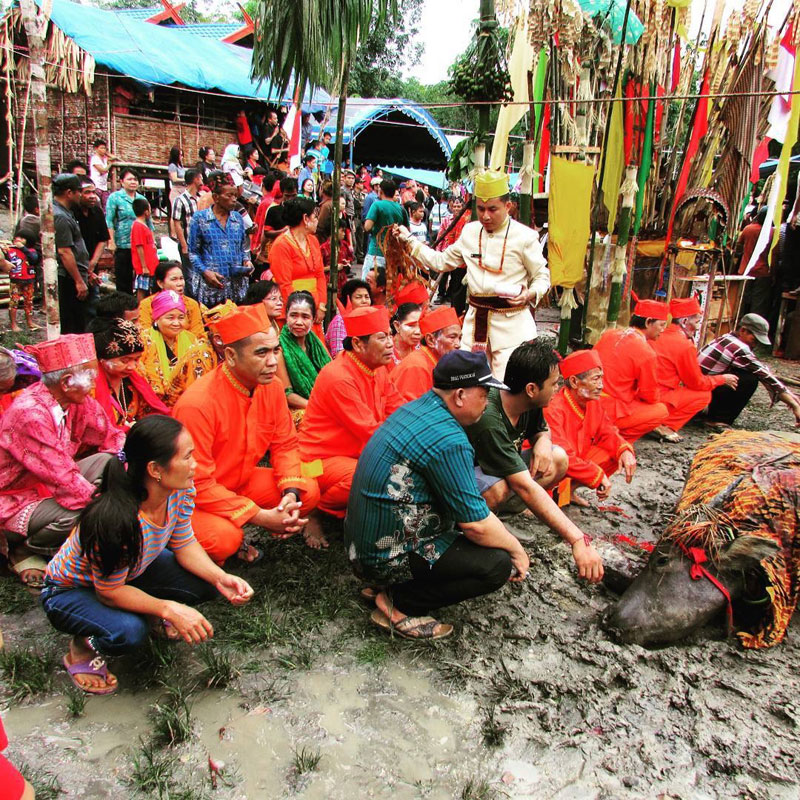
The ritual of Tiwah
Getting there: The Tiwah ritual can be found in several villages through Central Kalimantan. However, a massive Tiwah festival is held annually in Tumbang Manggu Village, Sanaman Mantikei, Katingan Regency, Central Kalimantan. A guide is highly recommended when visiting this place.
Coordinates here
Best time to catch the ritual: Every May or June
8. Skull bathing ritual – Nyobeng
Besides digging up the remains of their loved ones, another Dayak custom involves cleansing the skulls of village enemies.
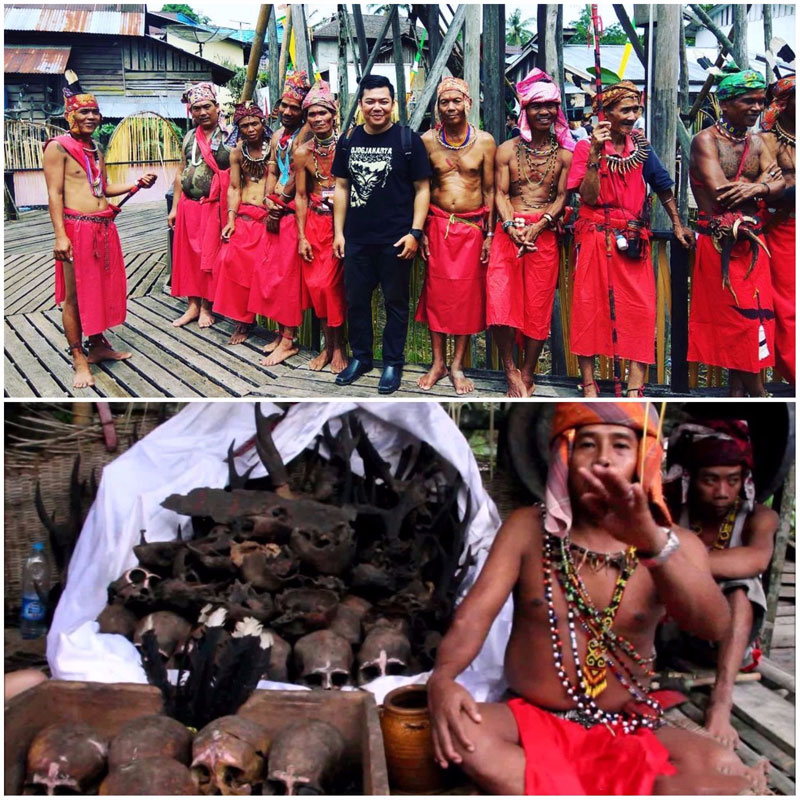
This fascinating (but definitely chilling) sacred ritual is referred to as Nyobeng. It involves cleansing and bathing the skulls of sacrificed humans obtained years ago by the villagers from a headhunting ritual called Mengayau, as this practice believes that a dried human skull possess powerful magic capable of good harvests and expelling evil.
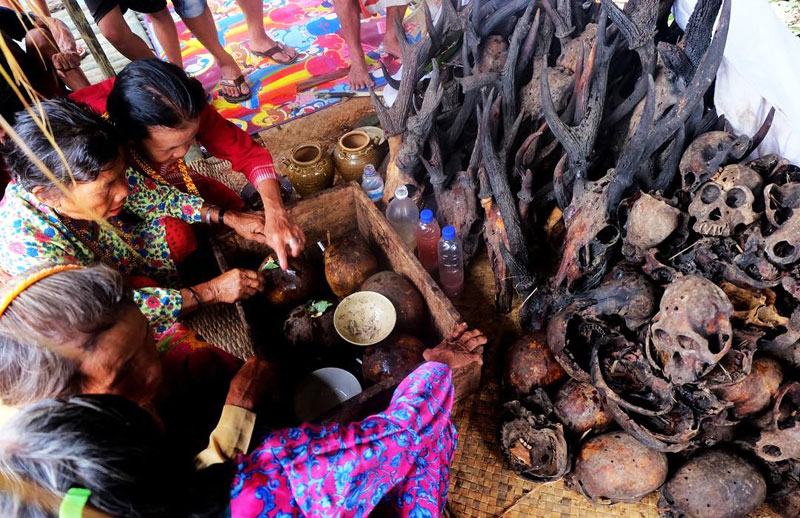
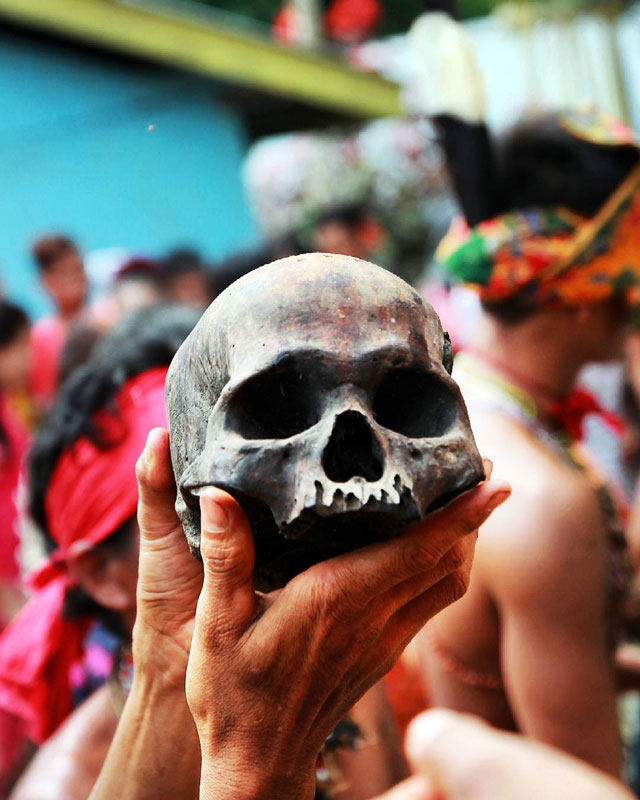
Although headhunting has now been banned by the government, the Nyobeng ritual still continues to this day as a way to express gratitude for good harvests.
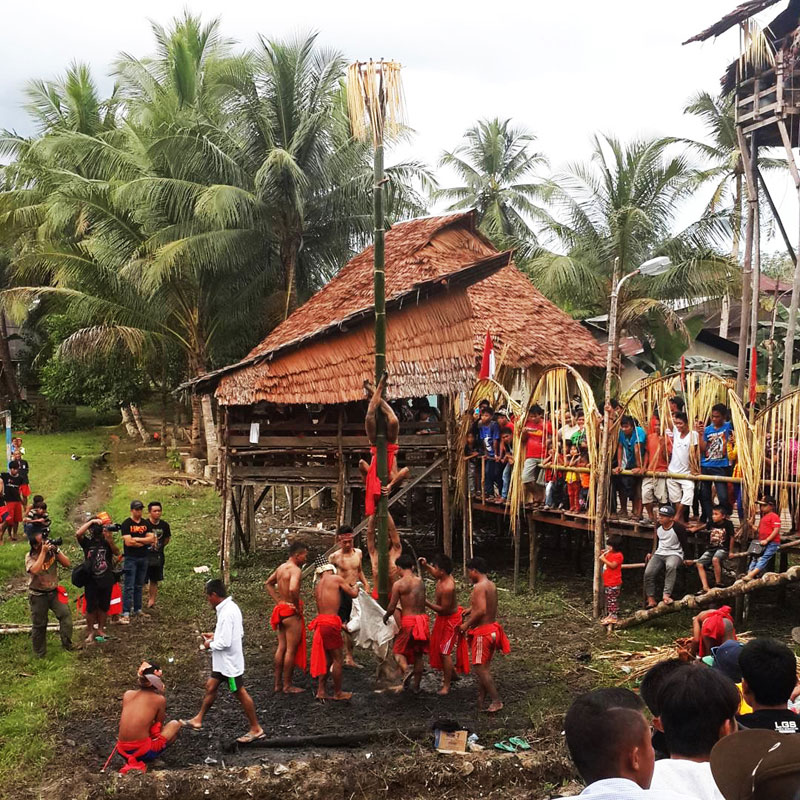
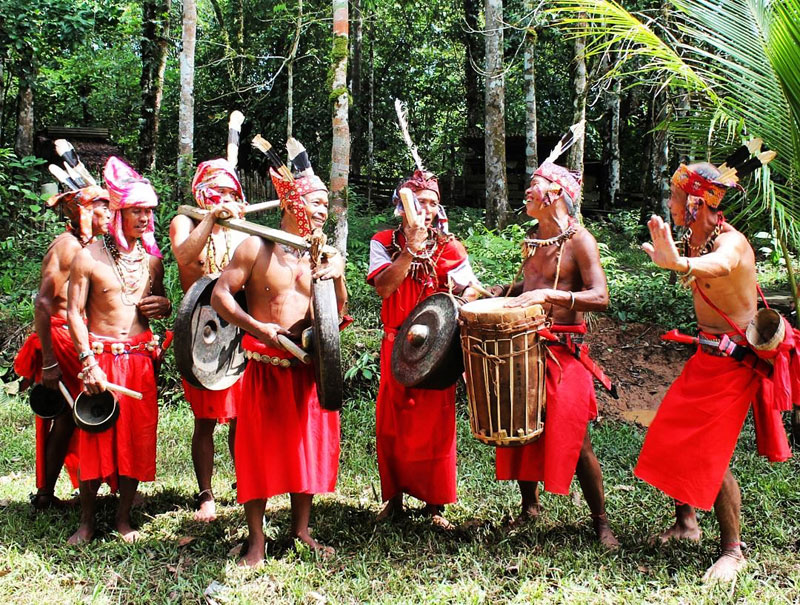
Nyobeng
Address: Dusun Hlu Bue, Kampung Sebujit, Siding, Kabupaten Bengkayang, Kalimantan Barat.
Getting there: Be mentally and physically prepared to visit Sebujit Village due to the terrible road conditions and a very long drive. Only motorcycles are recommended if you want to drive all the way to Sebujit from Pontianak. A guide is highly recommended when visiting this place.
From Pontianak, head toward Sungai Piyuh by driving northeast until you reach Bengkayang. Roads here are relatively smooth as most of them are in good condition. Keep driving towards Simpang Takek via Sanggau Ledo for 2 hours. After reaching Simpang Takek, take a short break. The remaining journey will be tough as you will need to drive off-road. It will take 6-8 hours to drive from Pontianak to Simpang Takek.
Let the local guide take over from here and drive very carefully because you will drive through a sandy path, on a wooden suspension bridge, along a steep cliff and other challenging routes until you reach Sebujit. The drive from Simpang Takek to Sebujit is around 18km (1.5 to 2 hours’ drive).
Coordinates here.
Best time to catch the ritual: Every 13th-17th June
9. Leap to adulthood – Fahombo
Located on the western coast of Sumatra Island, Nias is an exquisite island inhabited by the Austronesians race which even today remain culturally diverse and authentic. On this isolated Island, you can witness one of the most symbolic and challenging coming-of-age rituals still in practice today, known as Fahombo.
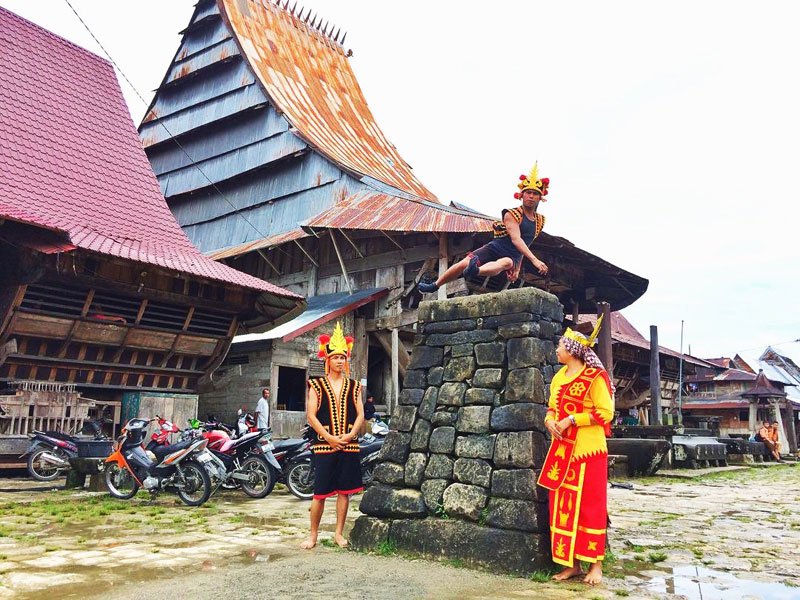
The art of Fahombo first emerged because of aggressive tribe wars. As a tactic for easy invasion of their enemies’ villages, the soldiers of Nias needed to be able to literally leap over the defense fort.
Although there are no tribal wars today and people live peacefully in Nias, this jumping tradition has become a local tradition of manhood and remains an important step in adulthood.
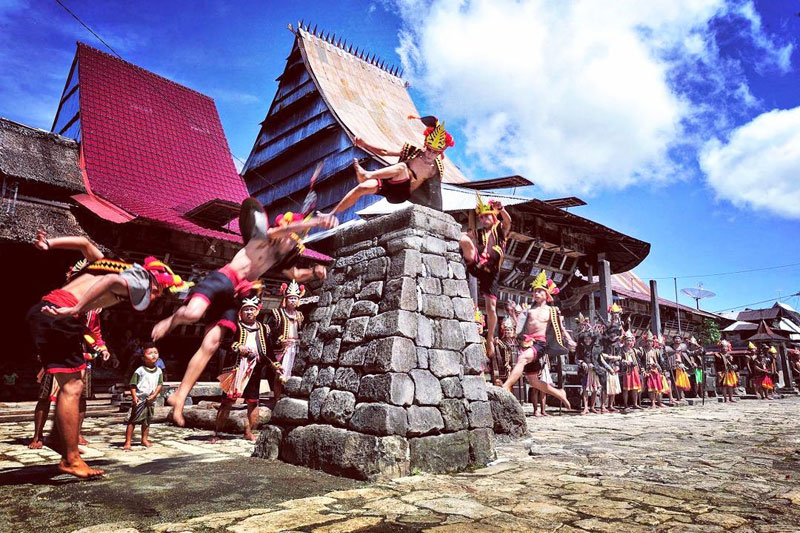
Nowadays, for the boys of Nias to fully reach manhood, they must prove their strength by leaping over a two-metre wall of stone as a sign of physical and mental maturity. Those who succeed are permitted to marry and defend their own village, signifying their acceptance into adulthood.
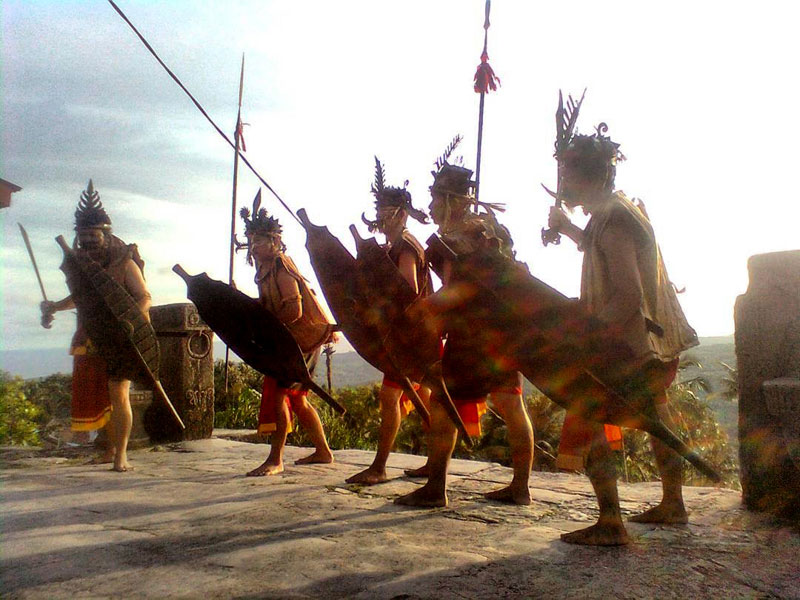
Watch this ritual before visiting the island yourself:
Years of practice are very important for these boys to perform such challenging acts. Not only must the leap be effective, but the landing must also be perfect, because even a small miscalculation or mistake may result in serious injuries.
Fun fact: this tradition is so symbolic and unique that the government had it printed on the Indonesia 1000 rupiah banknote in 1992!

Fahombo
Getting there:
By sea: From Medan city, take a 10-hour taxi ride to Sibolga (approximate fare Rp. 110,000/ USD 8.20) and transfer to the ferry there. The ferry will depart at 8pm and arrive at 6am (an economy seat costs Rp. 70,000 (approximately USD 5.20)). Coordinates here.
By air: There are regular flights that fly from Medan to Nias every day. Do book the flight in advance to avoid overpriced tickets!
Entrance fees: From Rp. 50,000 to Rp. 100,000 for off season, non-festival performances (approximately USD 3.76 to 75.14), free during Bawomataluo festival.
Best time to catch the festival: Bawomataluo is held every June.
10. The Ultimate Rice War – Tawur Nasi
Spain has the infamous tomato-throwing war, Thailand has an exciting water war, and Rembang in Indonesia has an amazing…rice war?
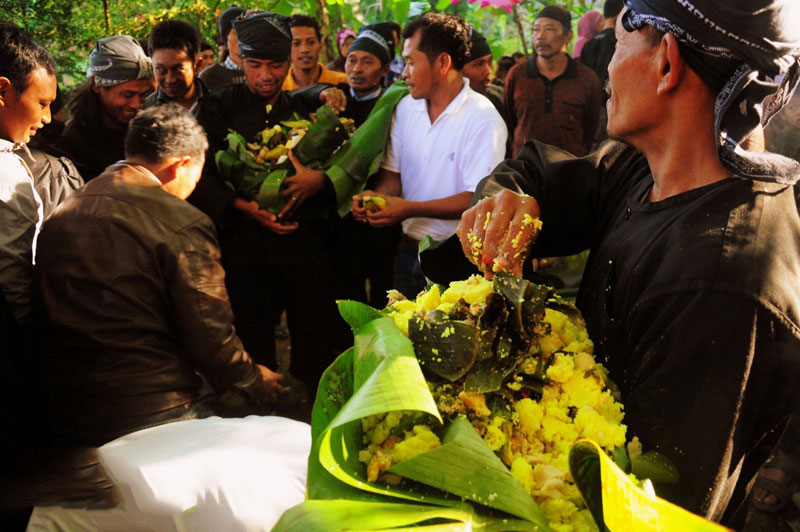
Yes, you read that right! The rice war, called Tawuran Nasi by the locals, is how the Rembangese express their gratitude for the abundant harvest. Having been practised for decades, you can still witness this gleeful tradition upon the arrival of every harvest season.
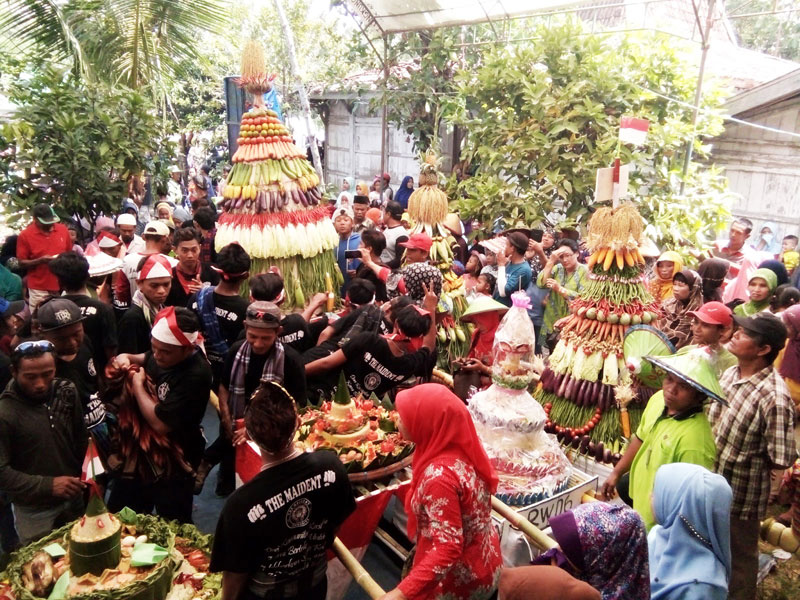
This tradition starts with the gathering of villagers who will each bring a large bowl of rice and pile it on a tarpaulin. The village leaders then lead a series of prayers of thanks. Finally, people can start to grab handfuls of rice and start flinging – the rice war begins!
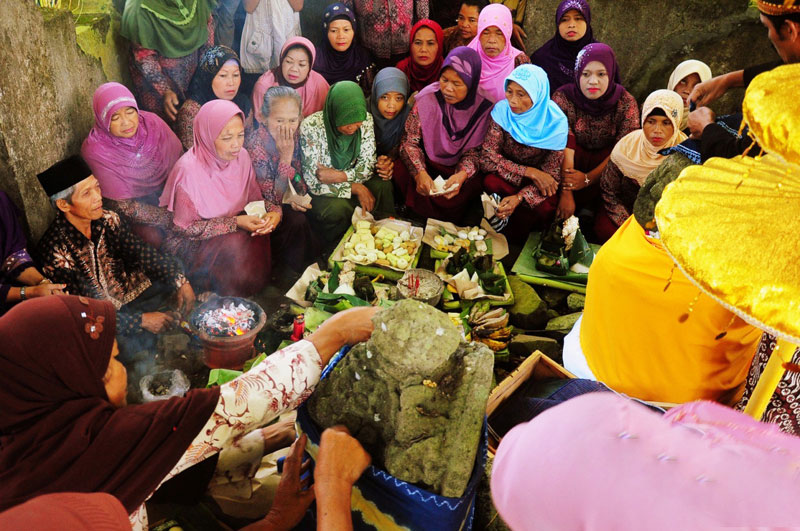
Worried about wasted food? There’s no wastage here – all of the post-war rice will be collected by the villagers and fed to the livestock.
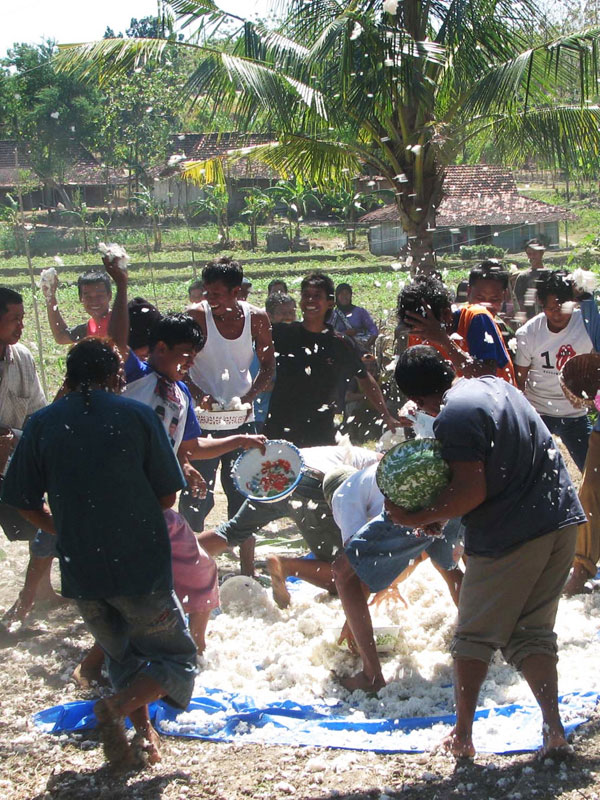
Tawur Nasi
Address : Desa Pelemsari, Sumber, Rembang Regency, Central Java, Indonesia
Getting there: From Semarang, drive northeast for 3-4 hours to Rembang. From Rembang, drive south for another hour to reach Pelemsari.
Coordinates here.
Best time to catch the ritual: Once a year, after the local harvest season. The date needs to be specially calculated by the village head every year.
11. Witness the generations of sultans – Grebeg Maulud
On the birthday of Prophet Muhammad, the people of Yogyakarta will cease their daily activities and gather in the Yogyakarta sultan’s palace to celebrate one of the most monumental events of the year, Grebeg Maulud.
Grebeg Maulud holds special meaning to the residents of Yogyakarta as this event was founded by their first sultan (king) to spread Islam. Years later, Grebeg Maulud also transformed into a Thanksgiving ceremony for the residents of Yogyakarta.
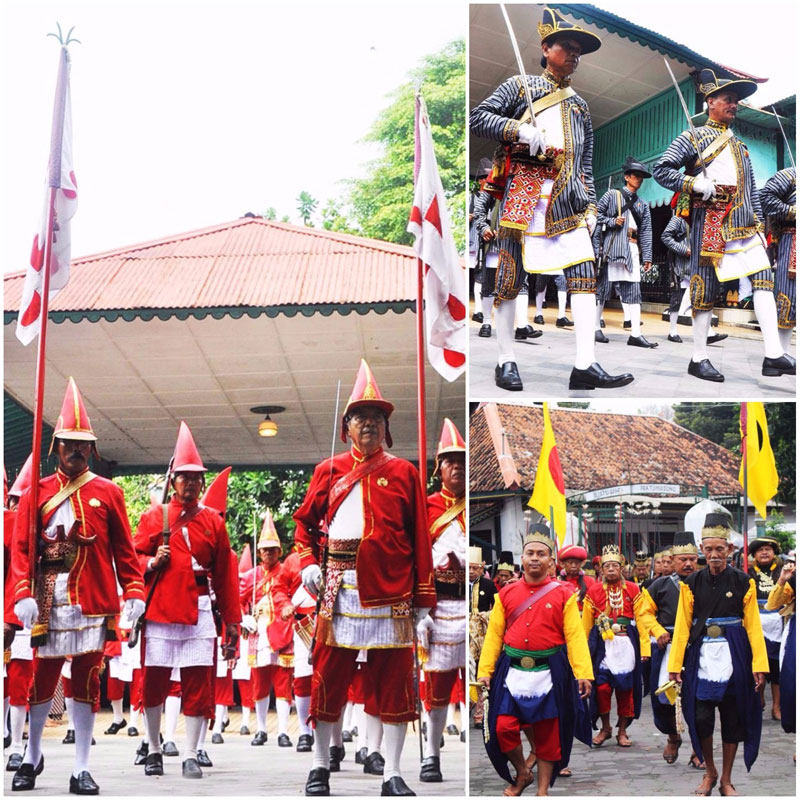
Grebeg Maulud usually begins with the parade of soldiers from 10 different generations, symbolising the 10 sultans who have reigned over the kingdom. Each group of soldiers will wear their own unique costume, weapon, and flag while parading through the flock of visitors.
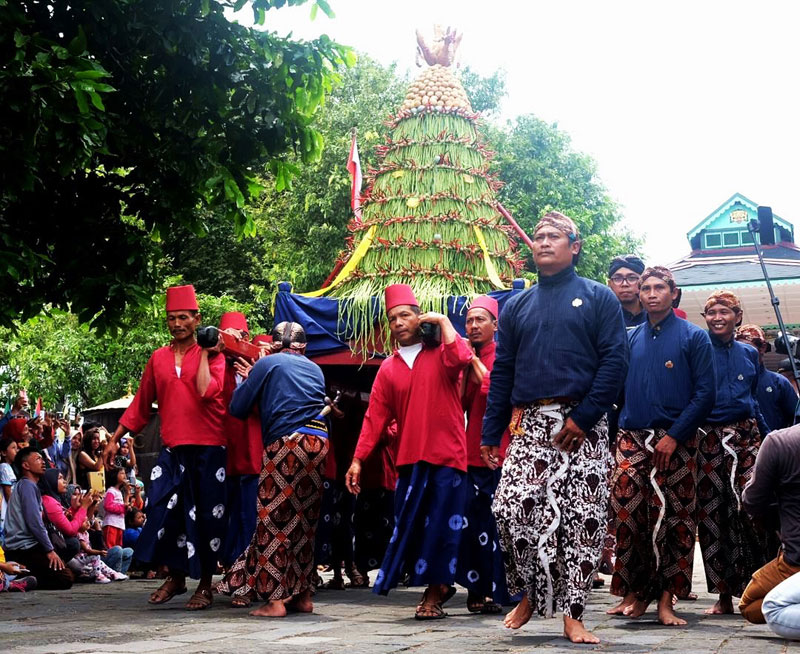
At the end of the parade, soldiers will distribute 7 massive piles of vegetables and food (called Gunungan) to the public. Due to the limited amount and overwhelming crowd, only very lucky participants will receive a part of the Gunungan, which also believed to be a sign of good fortune.
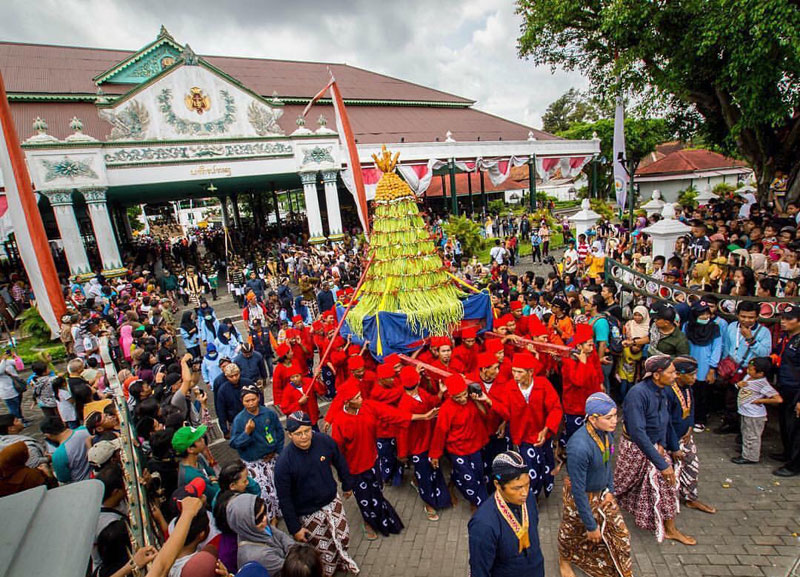
Grebeg Maulud
Address: Jalan Rotowijayan Blok No. 1, Panembahan, Kraton, Kota Yogyakarta, Daerah Istimewa Yogyakarta. Coordinates here.
Best time to catch the festival: Once a year on the 12th day of the 3rd month on the Javanese calendar (Prophet Muhammad’s birthday).
12. Aboriginal whaling – Lamalera’s whale hunting festival
If you happen to be travelling through Lamalera, you may be lucky enough to see dozens of fisherman hunting large sea animals like dolphins, manta rays, and even whales!
While there are many cultures where whales are protected and even revered, Lamalera is one of the last communities in the world to hunt whales (using just harpoon and ropes). And yes, although whale-hunting is prohibited internationally according to wildlife rights laws, the people of Lamalera are given special permission to do so.

This is because the act of whaling in Lamalera is categorised as aboriginal whaling – meaning the community only hunt whales for daily survival and not for commercial gain. For many small villages bordered by the sea, the ocean is the only source of food. This practice has deep roots in Lamalera traditions, having been practised since the 16th Century.
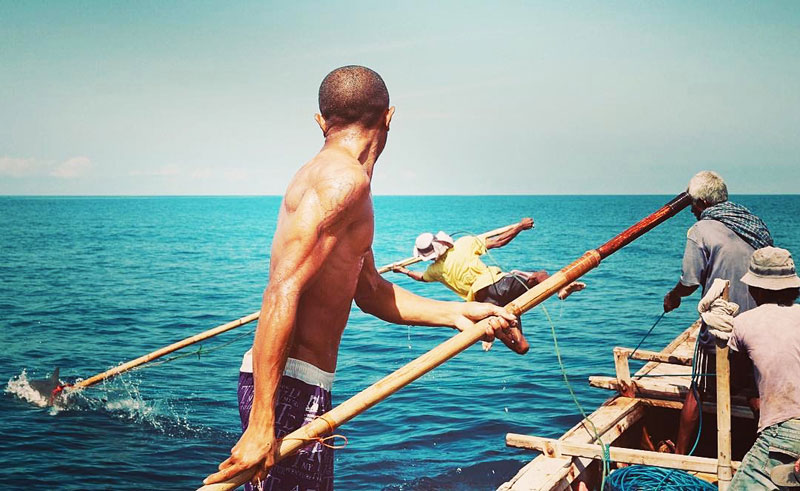
Whaling in Lamalera is done with the help of traditional wooden boats, using only harpoons and ropes. Upon spotting a whale, the spear is aimed at the animal and thrown into the whale’s flank. Assisting fishermen will continue to attack the prey until its death, and finally the dead whale will be brought back to the shore to be fairly distributed.

Although whaling is considered unethical in most parts of the world, it’s important to remember that authentic cultures do have different practices. And while it may be saddening to think of the death of such a magnificent creature, it’s for the sake of villagers’ survival and the survival of ancient cultures and customs.

Watch the video here:
Lamalera’s whale hunting festival
Getting there:
From Jakarta, take a flight to Kupang, NTT and transfer to Lembata via speed boat. After reaching Lembata, travel south for more than 5 hours to reach Lamalera. You can use local transportation called Otto to travel from Lembata to Lamalera (costs less than Rp. 50,000/ approximately USD 37.60).
Note: Please make sure there is a speed boat available on the day you are travelling because the schedule may differ daily.
Coordinates here.
Price: You can join the locals for whale-hunting by paying them Rp. 100,000 (approximately USD 7.50)
Best time to catch the ritual: The festival starts in early May and peaks in June.
13. Becoming woman dracula – Kerik Gigi
If you’re a woman, you’re probably all too familiar with the concept of “beauty is pain”. And this is the perfect saying to sum up this ritual.
On the island of Mentawai, having Dracula-like pointed teeth is the standard of beauty.

According to local beliefs, a woman with sharp teeth is more appealing and more likely to be happy and be at peace for the rest of her life than one with normal, square teeth.
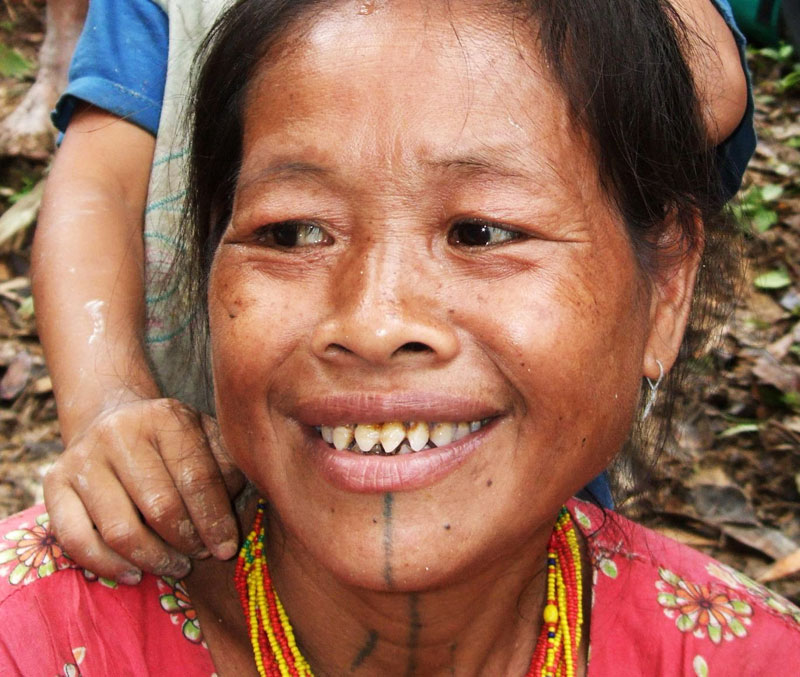
Curious about how this practice is performed?
By using roughly sharpened steel or wood, the village chief will start grinding and carving the woman’s teeth. The ritual could last for hours because every tooth needs to be perfectly shaved to a sharp tip.

If you’ve ever been to the dentist for an unpleasant procedure, you would probably have some form of anesthesia to manage the pain. For these women, no drugs are given to numb the throbbing pain during the ritual, nor are the sharpening tools sterilised. You can just imagine how much pain the ladies of Mentawai must endure to become what is considered beautiful!
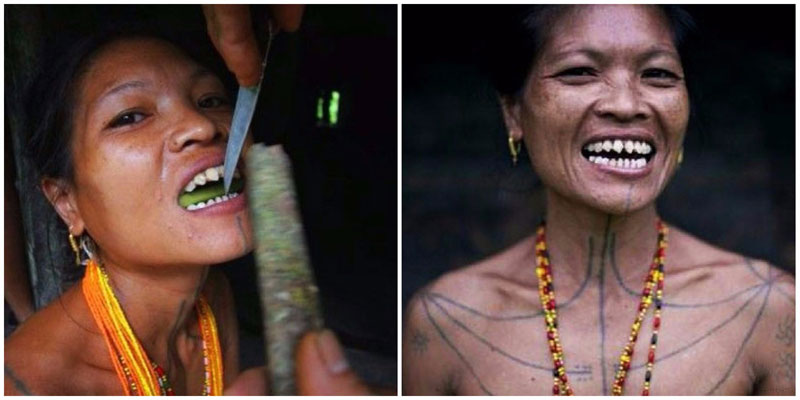
They believe that the pain is only temporary, but the happiness will last for eternity.
Kerik Gigi


 Bahasa Indonesia
Bahasa Indonesia 简体中文 (Chinese)
简体中文 (Chinese)